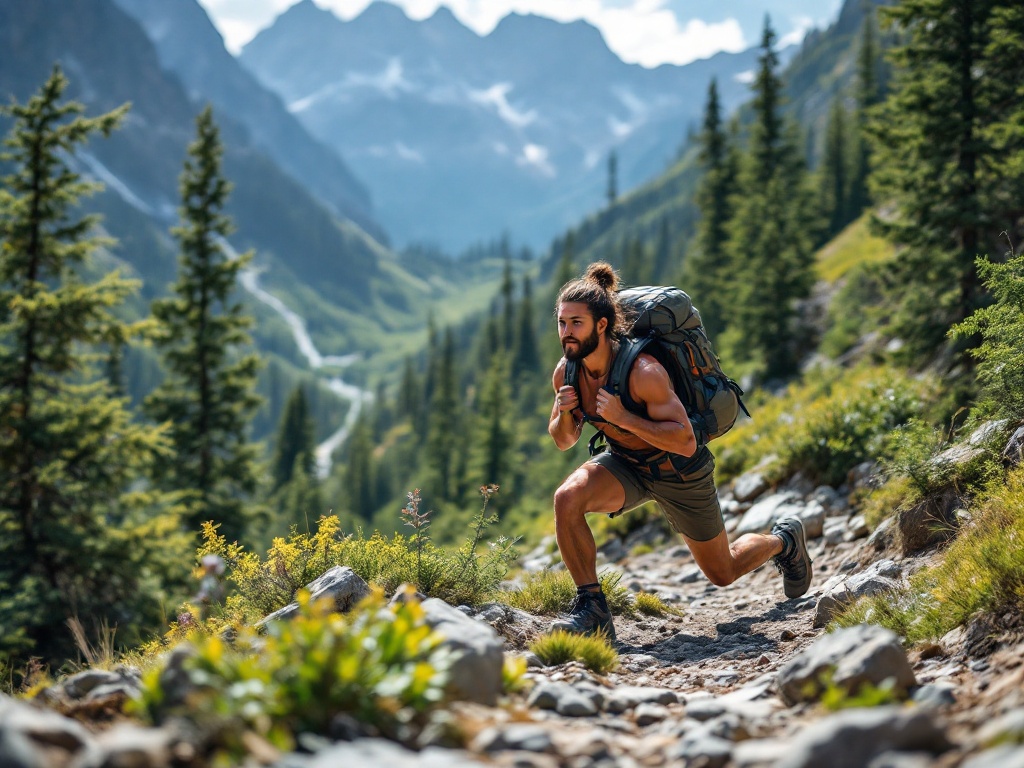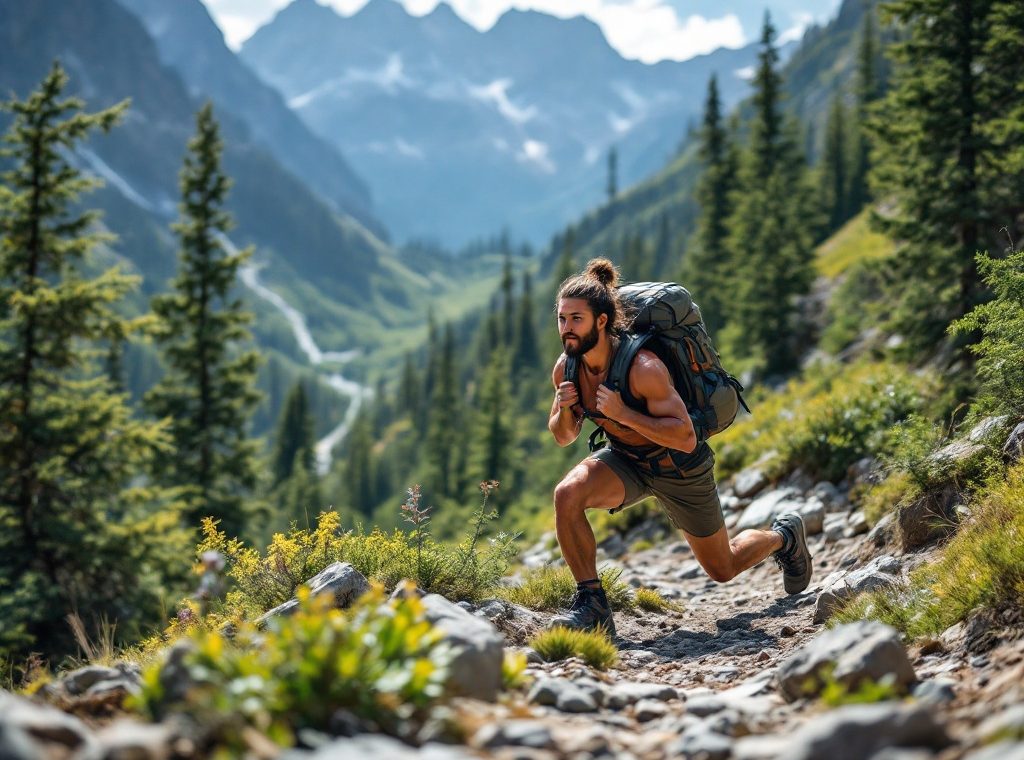How to Train for a Backpacking Trip? Build Strength, Stamina and Confidence
Ready to conquer the backcountry? Discover the secrets to a successful backpacking trip through targeted training. This comprehensive guide reveals how to build strength, boost endurance, and improve flexibility for those challenging climbs and long days on the trail. Learn how to design a personalized training plan, incorporating strength exercises, cardio workouts, and essential pack weight training. Start your journey towards a safer, more rewarding backpacking adventure today!
Important information

- Train for strength, cardio, and flexibility 8-12 weeks before a backpacking trip, especially for hikes over 12 miles.
- Strength training should focus on legs, core, and upper body; cardio should include LISS and HIIT; and flexibility training should involve stretching and yoga.
- Practice hiking with a weighted pack, starting with 15 pounds and gradually increasing the weight and distance.
- Prioritize rest, proper nutrition (carbs, protein, healthy fats), and hydration for optimal recovery and performance.
- Research trail conditions and weather, wear appropriate clothing and broken-in boots, and share your itinerary with someone you trust.
Understanding the Basics of Backpacking Training
Prepare for your backpacking adventure with a focused training plan. This plan involves building strength, improving cardiovascular fitness, and increasing flexibility. Strength training should focus on the muscles used while carrying a pack. Excellent cardio is essential for those long days on the trail. Flexibility will improve your mobility and aid in recovery.
Ideally, begin training eight to twelve weeks before your trip, particularly if you’re planning hikes exceeding 12 miles. Gradually increase your training intensity and the distance you cover.
A solid schedule incorporates two non-consecutive days of strength training and three non-consecutive cardio sessions, along with two essential rest days.
Two weeks prior to your departure, shift your focus to long day hikes, carrying a pack roughly 80% of your expected trip weight.
In the final days leading up to your trip, taper your training intensity to allow your body to recover fully. Prioritize rest, proper nutrition, and wearing the same well-fitting shoes and pack you’ll use on the trail.
Consider the trail conditions and weather you’ll encounter and train accordingly, aiming for four to five workouts per week. Combine strength training, cardio, and hiking.
Use similar gear during training as you’ll use on your trip, including broken-in hiking boots and a comfortable backpack. Trekking poles can also be beneficial.
Strengthen your legs, hips, and core with exercises like: jump squats, step-ups, hip rolls, and single-leg deadlifts. Improve your stability with squat curl overhead presses and side planks. This targeted training will prepare you for the physical challenges of backpacking.
Importance of Cardiovascular Fitness
Cardiovascular fitness is essential for backpacking, allowing you to handle long hikes, challenging climbs, and extended treks. A strong cardiovascular system efficiently delivers oxygen to your muscles, reducing fatigue and improving trail performance. This efficiency also leads to better energy use, which is crucial when carrying a heavy pack. Furthermore, good cardiovascular health boosts overall well-being, increasing backpacking enjoyment and enabling you to continue this activity for years to come.
Key Muscles Used in Backpacking
Backpacking requires strength from key muscle groups. These include your quads, hamstrings, glutes, and core. These muscles stabilize and strengthen you for hiking, bearing your pack’s weight, and helping you navigate challenging terrain. Strengthening them is crucial for injury prevention and backpacking efficiency.
Developing a Comprehensive Backpacking Training Plan
Strength, endurance, and specialized pack training are essential for conquering the backcountry. A comprehensive training plan addresses all three. Strength training develops the muscles needed for carrying heavy loads. Endurance training prepares you for long days on the trail. Pack training simulates the actual experience by having you hike with a weighted pack. This combined approach maximizes your performance, minimizes fatigue, and prevents injuries by conditioning your body for challenging terrain and heavy packs. With a structured plan, you’ll be well-prepared to enjoy your backpacking adventure.
The Role of Strength, Endurance, and Pack Training
Strength training is crucial for tackling steep climbs with a heavy pack, building essential muscle power.
Pack training prepares your body for the burden of your gear.
Endurance training is equally important, allowing you to hike longer distances.
Combining these training methods minimizes the risk of injury and boosts overall performance on backpacking trips.
These three elements are fundamental to successful backpacking, enhancing cardiovascular fitness and readying your body for the physical demands of the trail. Train strategically and enjoy a safer, more rewarding experience.
Designing a Training Schedule
Begin training eight weeks prior to your backpacking trip. A solid weekly regimen involves two non-consecutive days of strength training to build muscle, complemented by three non-consecutive days of cardio for enhanced endurance. Crucially, incorporate two rest days for recovery.
Two weeks before departure, shift your focus to long day hikes with a weighted pack, approximating 80% of your intended trip weight. This simulates the actual backpacking experience.
In the final days leading up to your adventure, taper your training intensity to allow for full recovery, ensuring you’re primed and ready for the trail.
Building Strength for Tough Climbs
Strength training is crucial for backpacking success. Focus on exercises that target key muscle groups for optimal performance on the trail.
Lower Body
Building powerful legs is essential for carrying a heavy pack and navigating varied terrain. Concentrate on:
- Squats, lunges, and step-ups: these exercises target your glutes, quads, and hamstrings, the primary muscles used in hiking.
- Calf raises: strengthen your lower legs to improve stability and prevent injuries on uneven trails.
Upper Body
Upper body strength is vital for carrying a loaded pack comfortably and efficiently. Incorporate these exercises:
- Push-ups and shoulder presses: build essential upper body strength, reducing strain and fatigue while carrying your pack.
- Deadlifts: strengthen your back, improving posture for long hikes and preventing back pain.
Core
A strong core improves balance and stability, reducing the risk of falls and injuries. Recommended exercises include:
- Planks and crunches: engage your core muscles to enhance stability and support your back.
- Yoga and Pilates: improve flexibility, core strength, and balance, aiding injury prevention.
Training Plan
Follow these guidelines to maximize your training:
- Frequency: aim for 2-3 workouts per week.
- Repetitions: perform 10-20 repetitions for lower and upper body exercises, and 20-30 repetitions for core work.
- Sets: do multiple sets to build endurance.
- Progression: practice loaded backpack lifts, gradually increasing the weight to simulate real backpacking conditions.
Essential Strength Training Exercises
Strengthen your legs with exercises like: squats, lunges, and step-ups. These build the necessary power for hiking uphill and downhill. A strong core is also crucial for balance and stability on the trail, so incorporate planks and Russian twists into your routine. For shoulder strength, important for carrying a backpack, try shrugs and farmer’s carries.
- squats,
- lunges,
- step-ups.
Enhance your upper body strength with push-ups and weighted backpack lifts. Supplement this with core work like plank holds and side twists to improve your balance and stability. Don’t neglect your calves; calf raises will strengthen these essential muscles for navigating uneven terrain. Finally, consider adding yoga or Pilates to your routine to improve flexibility and core stability, both invaluable when hiking on challenging trails.
- push-ups,
- weighted backpack lifts,
- plank holds,
- side twists,
- calf raises,
- yoga or Pilates.
For longer treks, consider adding exercises like loaded backpack lifts, jump squats, hip rolls, and single-leg deadlifts to your routine. These exercises enhance stability and endurance, preparing you for the challenges of extended hikes.
- loaded backpack lifts,
- jump squats,
- hip rolls,
- single-leg deadlifts.
Upper and Lower Body Strength Workouts
Focus on Legs: incorporate squats, lunges, and step-ups into your training to build leg strength essential for backpacking.
Strengthen Your Upper Body: perform push-ups, shoulder presses, and rows to build strength in your arms, shoulders, and back for carrying a pack.
Develop Core Strength: planks, side planks, and Russian twists are excellent exercises for core strengthening, essential for balance and stability on the trail.
Practice with a Loaded Pack: simulate real backpacking conditions by practicing lifting your loaded pack.
Training Schedule: aim for two or three strength-training sessions per week, performing two to three sets of 10 to 15 repetitions for each exercise.
Progressive Overload: as you progress, gradually increase the weight or resistance to continually challenge your muscles and prepare for any backpacking adventure.
Enhancing Endurance for Long Hikes
Preparing for long hikes necessitates building cardiovascular fitness and stamina. Excellent ways to achieve this include activities like brisk walking, running, or cycling. Aim for a minimum of 150 minutes of moderate-intensity exercise or 75 minutes of vigorous activity per week. Two popular training methods are LISS and HIIT.
Low-Intensity Steady State (LISS)
LISS involves maintaining a comfortable pace for an extended period. A long walk is a good example of LISS training. This method effectively improves cardiovascular health and builds endurance for hiking.
High-Intensity Interval Training (HIIT)
HIIT utilizes short bursts of intense exercise followed by brief recovery periods. A typical HIIT workout might involve 30-second sprints interspersed with one-minute walks. This training method enhances cardiovascular health and hiking endurance.
Combining both LISS and HIIT in your training plan can yield optimal results for improved cardiovascular health and hiking endurance.
Cardiovascular Fitness and Endurance
A strong heart is crucial for backpacking. Excellent cardiovascular fitness enables you to handle longer hikes with reduced fatigue. Activities such as running, cycling, and swimming are excellent for boosting heart health, and hiking itself is superb preparation.
- running,
- cycling,
- swimming.
Interval training, alternating intense bursts of activity with rest periods, is another highly effective method for improving cardiovascular capacity. Don’t neglect moderate aerobic exercise like hiking, running, or even brisk walking. Swimming and cycling also offer significant benefits.
- LISS (low-intensity steady-state exercise) for building endurance,
- HIIT (high-intensity interval training) for challenging trails and higher altitudes.
Aim for 150 minutes of moderate aerobic activity weekly to maximize your cardio fitness and minimize the risk of injuries.
Low-Intensity Steady State vs. High Intensity Interval Training (HIIT)
LISS
LISS, or low-intensity steady state, involves moderate, sustained effort to build endurance and burn fat. A moderate-paced walk exemplifies LISS. LISS is a valuable tool for backpacking training, enhancing endurance for long hikes.
HIIT
HIIT, or high-intensity interval training, uses short bursts of intense activity followed by brief recovery periods. Short, uphill sprints represent HIIT. HIIT is excellent for cardiovascular health and rapid calorie burning. It is a valuable tool for backpacking training.
Improving Flexibility and Balance
Maintaining balance on uneven trails is essential for preventing falls and injuries. These trails often present obstacles like rocks and roots, and good balance helps you navigate them safely. Flexibility also plays a vital role in injury prevention by reducing muscle strain.
Improve Your Balance and Flexibility
Improve your balance and flexibility through stretching, yoga, and targeted exercises. These activities prepare your body for the demands of the trail. Focus on strengthening key muscle groups such as quads, calves, and hamstrings with exercises like lunges, which also boost mobility.
- stretching,
- yoga,
- targeted exercises.
Enhance Overall Mobility
Beyond injury prevention on the trail, flexibility training enhances overall mobility, making everyday movements easier, from filling water bottles to simply walking around. Stretching, yoga, and foam rolling also alleviate muscle soreness and tension, contributing to a more comfortable backcountry experience.
Single-Leg Standing
Practice single-leg standing on varied surfaces like grass, concrete, or gravel, holding for 30-60 seconds per leg.
Added Challenge
For an added challenge, try single-leg standing with a loaded backpack to engage stabilizing muscles and further minimize injury risk.
Flexibility and Balance Exercises
Yoga and Pilates are excellent for enhancing flexibility and building core strength, essential for any hiker.
Holding stretches for five minutes after hikes or workouts significantly improves range of motion.
Foam rolling is a great way to alleviate muscle soreness and tension after a long day on the trail.
These practices also contribute to improved balance and stability, crucial for navigating uneven terrain while hiking.
Balance and Stability on Uneven Terrain
Balance training is crucial for navigating uneven trails, enhancing stability and coordination to prevent falls. Try single-leg stands, holding each for 30-60 seconds on varied surfaces like grass or gravel. Adding your backpack creates a realistic hiking challenge.
Strengthening key muscles is also important. Exercises such as jump squats, step-ups, hip rolls, and single-leg deadlifts improve balance.
For even greater stability, incorporate squat curl overhead presses and side planks. Consistent practice will build your confidence on the trail.
Training with a Loaded Backpack
Pack weight training is crucial for a successful backpacking trip. It strengthens essential muscle groups such as quads, hamstrings, glutes, and your core, which improves balance and stability on uneven trails. This focused training prepares your body for the specific strain of carrying a pack, minimizing the risk of injury and allowing for pre-trip gear adjustments for maximum comfort. It also builds confidence and mental fortitude for the challenges of backpacking.
Start training with approximately 15 pounds in your pack to simulate gear weight. Concentrate on maintaining good posture and balance while walking.
Gradually increase both pack weight (by about 10% every week or two) and mileage. This helps build fitness and prevent overexertion.
Vary your training terrain by incorporating hills and uneven surfaces to mimic real-world backpacking conditions. This progressive approach will effectively prepare your body for the physical demands of your trip.
Benefits of Pack Weight Training
Pack weight training is crucial for backpacking, strengthening essential leg, core, and back muscles. This reduces injury risk and improves balance on challenging trails. Begin with a light pack, around 15 pounds, gradually increasing weight and distance to simulate a real backpacking experience and enhance hiking efficiency. A well-fitted backpack is also vital, distributing weight evenly for comfort and preventing injuries like strained shoulders and back, or balance issues. Choose your pack wisely.
Gradual Weight Increase and Mileage Progression
Start with shorter hikes and a light pack.
Gradually increase the distance and weight you carry, paying close attention to your body’s signals.
Adjust your hikes based on how your body feels. If a hike feels too easy, consider adding weight or distance.
If a hike is too challenging, reduce the weight or distance.
A good way to simulate backpacking is by adding water bottles to your pack; this method safely builds strength and helps prevent injuries.
Importance of Proper Recovery and Nutrition
Muscle growth depends heavily on rest, which allows your body to recover and repair muscle tissue after exercise. Be sure to incorporate rest days into your fitness routine. Rest can include:
- sleep,
- stretching,
- foam rolling.
Prioritize sleep for optimal recovery and hormone regulation.
Proper nutrition is essential for fueling both your training and backpacking adventures. A balanced diet with carbohydrates, proteins, and healthy fats is crucial.
- Carbohydrates provide energy.
- Protein aids in muscle repair.
- Healthy fats are essential for hormone production.
Staying hydrated is also vital for performance and recovery. Replenish lost electrolytes with sports drinks or electrolyte tablets. For personalized guidance, consult a nutritionist.
Importance of Rest and Recovery
Prioritize rest for muscle repair and growth to prevent injuries like sprains, strains, and overuse.
Incorporate rest days, stretching, and foam rolling into your training plan.
As your body strengthens, performance and resilience will improve.
Prioritize sleep for both physical and mental recovery to boost your training’s effectiveness.
Nutrition for Sustaining Energy
Fuel your body with a balanced mix of carbohydrates, proteins, and fats. Carbohydrates, found in foods like rice, pasta, and bread, provide quick energy. Protein, essential for building and repairing muscles, comes from sources such as beans, lentils, and meat. Healthy fats, like those in nuts, seeds, and avocados, deliver sustained energy. Prioritize nutrient-rich whole foods over processed options for optimal fuel. Hydration is also crucial, so drink plenty of water throughout the day, increasing your intake during activities like hiking. Remember to consult a healthcare professional or registered dietitian for personalized dietary advice.
Injury Prevention and Safety Tips
Planning a hike requires understanding the trail. Check the terrain and weather forecast, and be aware of potential hazards. Thorough research, including recent trip reports, is key to a safe and enjoyable experience. Pack accordingly, paying close attention to your clothing and footwear choices. Consider the climate and terrain when making these decisions.
Clothing
Opt for moisture-wicking fabrics and insulating layers. Waterproof outerwear is essential, as mountain weather can change rapidly.
Footwear
Sturdy, supportive boots with good traction are vital for navigating uneven terrain and preventing ankle injuries.
With proper preparation, you’ll be ready to safely enjoy your hike.
Preparing for Trail Conditions
Planning a hike requires careful preparation. Before you head out, research the trail conditions, including elevation changes and terrain type (rocky, muddy, snowy). Consider potential obstacles like river crossings. Pack accordingly, bringing navigation tools such as a map and compass, a well-stocked first-aid kit, and extra layers of clothing. Check the weather forecast and adjust your plans if needed. Share your itinerary and estimated return time with someone you trust.
Research trail conditions, including elevation changes and terrain type (rocky, muddy, snowy).
Consider potential obstacles like river crossings.
Pack essential items, including navigation tools (map and compass), a first-aid kit, and extra clothing.
Check the weather forecast and adjust your plans accordingly.
Share your itinerary and estimated return time with a trusted contact.
Clothing and Footwear Considerations
For a comfortable hike, choose moisture-wicking fabrics like synthetics or merino wool over cotton to stay dry. Dressing in layers allows you to adapt to changing weather conditions.
- Choose moisture-wicking fabrics,
- dress in layers,
- stay dry.
Invest in sturdy, waterproof hiking boots with good ankle support. Ensure a proper fit and break them in before your hike to prevent blisters. Gaiters offer additional protection from debris and water.
- Invest in sturdy, waterproof hiking boots,
- ensure a proper fit,
- break them in before your hike,
- use gaiters for additional protection.
Using Technology and Resources for Training
Smartwatches and fitness trackers are invaluable tools for hikers, recording key metrics like distance, pace, heart rate, and elevation gain. Hiking apps enhance this by providing trail maps, navigation tools, and information on terrain, weather, and even permit requirements. Used together, these technologies empower hikers to plan routes, track their progress, and stay safe on the trail.
Smartwatches and Fitness Tracking
Smartwatches are excellent fitness companions that track vital metrics like heart rate, distance, and calories burned. This data is invaluable for tailoring and refining your training plan. Fitness apps on these watches monitor workouts, displaying your progress and sending motivating reminders to help you stay focused. Furthermore, these apps often connect you with friends, boosting accountability and encouraging consistent exercise. This social connection motivates more regular workouts. Here’s how smartwatches enhance your fitness journey:
Track Key Metrics
Monitor vital metrics like heart rate, distance, and calories burned to tailor and refine your training plan.
Workout Monitoring and Motivation
Fitness apps track your progress, display real-time stats, and send motivating reminders to keep you focused and engaged.
Social Connection and Accountability
Connect with friends to share your progress, boost accountability, and encourage consistent exercise.
Motivation for Regular Exercise
The social aspect of fitness apps motivates you to maintain a regular workout routine.
Hiking Resources and Tools
Enhance your hiking experience with these valuable resources:
- Hiking apps: these excellent navigation tools often provide helpful trail information.
- Dedicated hiking websites: these offer valuable resources like trail maps, gear reviews, and essential safety tips.
- Online hiking communities: connect with fellow hikers, share experiences, and learn from each other.
- Hiking and backpacking books: find in-depth information on training plans, gear selection, and crucial wilderness skills.
- Experienced hikers or certified trainers: consult them for truly personalized guidance.
Building Confidence and Mindset Strategies
Start with achievable goals and gradually increase your training intensity.
Short trips are great for practicing skills and building confidence.
Visualization is key. Mentally preparing for challenges can significantly impact your success.
Consistent training is essential for developing physical and mental resilience.
An accountability partner or group offers valuable support and motivation.
Track your progress and celebrate milestones to reinforce positive outcomes and boost confidence.
Strategies for Confidence Building
Visualize your triumph on the trails. Recall past successes; they empower future achievements. Discover inspiration that truly moves you.
Divide your training into smaller, achievable steps.
Integrate these activities into your everyday routine.
Acknowledge and appreciate each milestone.
Maintain a positive outlook; it’s transformative.
The Role of Consistent Training and Accountability
Consistent training is essential for successful backpacking trips. It prepares you both physically and mentally for the challenges ahead.
Accountability plays a key role in maintaining your training commitment. Find a training partner or join a group to stay motivated.
Take advantage of fitness apps and smartwatches. They allow you to monitor your progress, track your fitness levels, and stay motivated.
Connect with friends















